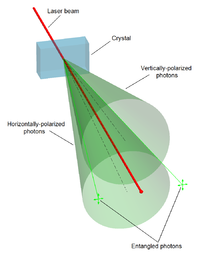
Photo from wikipedia
The quantization of the electromagnetic field leads directly to the existence of quantum mechanical states, called Fock states, with an exact integer number of photons. Despite these fundamental states being… Click to show full abstract
The quantization of the electromagnetic field leads directly to the existence of quantum mechanical states, called Fock states, with an exact integer number of photons. Despite these fundamental states being long-understood, and despite their many potential applications, generating them is largely an open problem. For example, at optical frequencies, it is challenging to deterministically generate Fock states of order two and beyond. Here, we predict the existence of an effect in nonlinear optics, which enables the deterministic generation of large Fock states at arbitrary frequencies. The effect, which we call an n-photon bound state in the continuum, is one in which a photonic resonance (such as a cavity mode) becomes lossless when a precise number of photons n is inside the resonance. Based on analytical theory and numerical simulations, we show that these bound states enable a remarkable phenomenon in which a coherent state of light, when injected into a system supporting this bound state, can spontaneously evolve into a Fock state of a controllable photon number. This effect is also directly applicable for creating (highly) squeezed states of light, whose photon number fluctuations are (far) below the value expected from classical physics (i.e., shot noise). We suggest several examples of systems to experimentally realize the effects predicted here in nonlinear nanophotonic systems, showing examples of generating both optical Fock states with large n (n > 10), as well as more macroscopic photonic states with very large squeezing, with over 90% less noise (10 dB) than the classical value associated with shot noise.
Journal Title: Proceedings of the National Academy of Sciences of the United States of America
Year Published: 2022
Link to full text (if available)
Share on Social Media: Sign Up to like & get
recommendations!